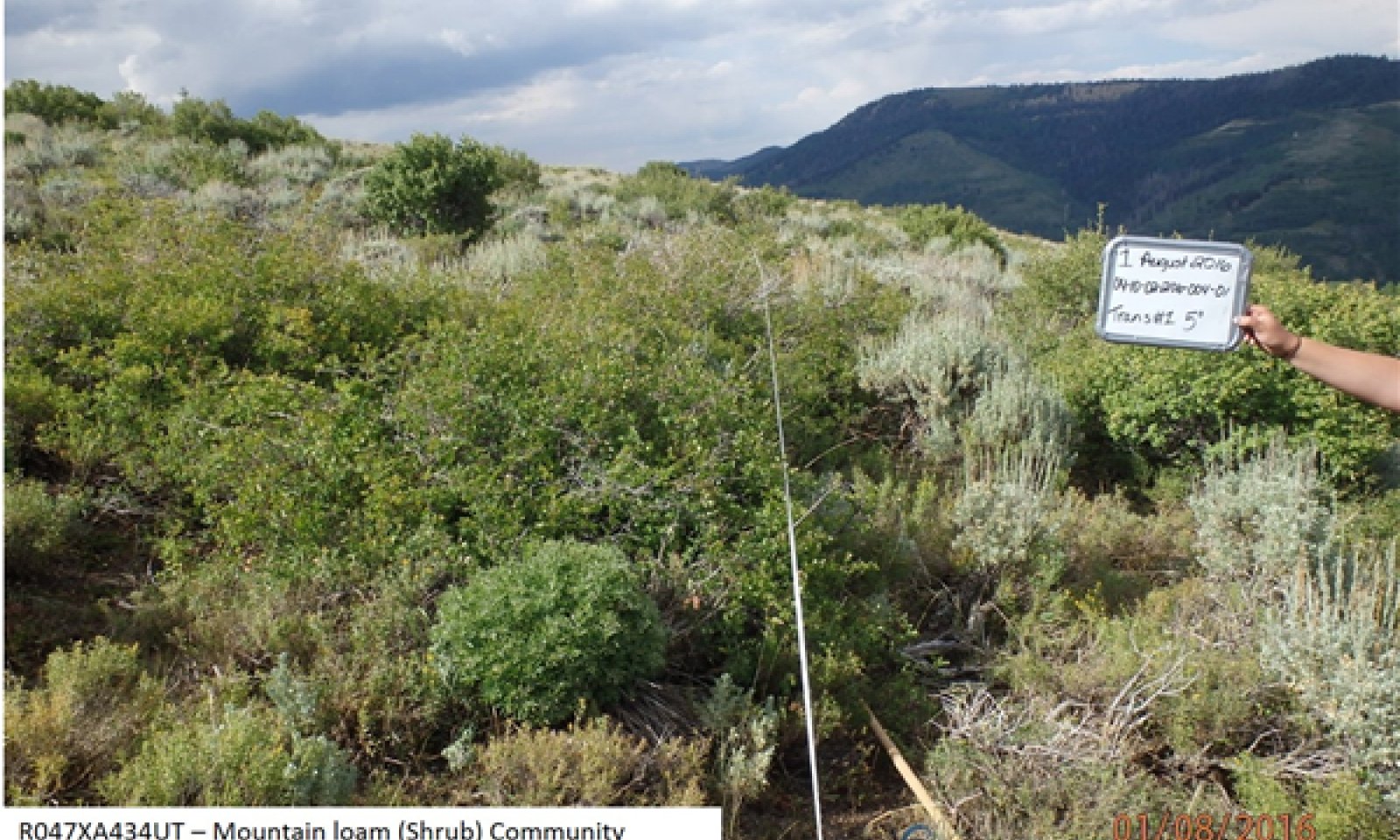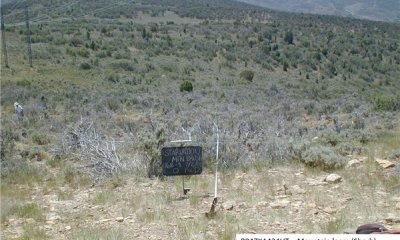
Mountain Loam (shrub)
Scenario model
Current ecosystem state
Select a state
Management practices/drivers
Select a transition or restoration pathway
-
Transition T1a
introduction of exotic species
More details -
Transition T2a
range seeding often in combination with a natural/prescribed fire or other brush management treatment
More details -
No transition or restoration pathway between the selected states has been described
Target ecosystem state
Select a state
Description
The Reference State is a description of this ecological site just prior to Euro-American settlement but long after the arrival of Native Americans. The description of the Reference State was determined by NRCS Soil Survey Type Site Location information and familiarity with rangeland relict areas where they exist. The least modified plant community (1.1) within the Reference State would have been a sagebrush-dominated stand with mountain big sagebrush (Artemisia tridentate spp. vaseyana), mountain snowberry (Symphoricarpos oreophilus) and associated bunch grasses such as bluebunch wheatgrass (Pseudoroegeneria spicata), Nevada bluegrass (Poa secunda) and slender wheatgrass (Elymus trachycaulus). Forbs such as arrowleaf balsamroot (Balsamorhiza sagittata), sticky purple geranium (Geranium viscosissimum) and fleabane (Erigeron sp.) would be present. Fire is believed to be the dominant disturbance force in natural big sagebrush communities. The reference plant community (1.1) would have been relatively stable with occasional use by wildlife. Following a natural fire (1.1a) and depending on the severity, would have killed most if not all of the sagebrush favoring the sprouting shrubs and bunchgrasses (1.2). Over time and without any further disturbances (1.2a) sagebrush and other non-sprouting shrubs would slowly come back into the site (1.3), however the sprouting shrubs and bunch grasses would still dominate the site. If there were another fire to occur on the site (1.3a) the site would return to community phase 1.2. If community phase 1.3 continued to experience no disturbances over a longer period of time (1.3b) it would eventually show a co-dominance between mountain big sagebrush and the other shrubs on the site. A more complete list of species by lifeform for the Reference State is available in the accompanying tables in the “Plant Community Composition by Weight and Percentage” section of this document.
Submodel
Description
State 2 is identical to State 1 in form and function, with the exception of the presence of non-native plants and animals, possible extinctions of native species, and a different climate. State 2 is a description of the ecological site shortly following Euro-American settlement, which can be regarded as the current potential. The least modified plant community (2.1) within State 2 is a sagebrush (Artemisia tridentate spp. vaseyana) dominated state with mountain snowberry (Symphoricarpos oreophilus) and associated bunch grasses such as bluebunch wheatgrass (Pseudoroegeneria spicata), Nevada bluegrass (Poa secunda) and slender wheatgrass (Elymus trachycaulus). Forbs such as arrowleaf balsamroot (Balsamorhiza sagittata), sticky purple geranium (Geranium viscosissimum) and fleabane (Erigeron sp.) would be present. A common non-native species in this state is cheatgrass. Fire is believed to be the dominant disturbance force in natural big sagebrush communities. Following brush management or fire (2.1a) and depending on the severity, would have killed most if not all of the sagebrush, and other non-sprouting shrubs, favoring the sprouting shrubs and bunchgrasses (2.2). This plant community is relatively stable under mixed use by wildlife and livestock. However, heavy utilization by bison, elk, horses, and domestic cattle on these sites during the growing season (2.1b) would deplete the grasses and deciduous shrubs creating site that is dominated by mountain big sagebrush (2.3). In community 2.2, when management, such as prescribed grazing, can be combined with time (2.2a) to allow the site to recover returning to community 2.1. However if the community continues to be over utilized by both wildlife and domestic livestock, and possibly in combination with a natural or man caused disturbance (2.2b) this community (2.2) can be degraded to community 2.4 which is dominated by rhizomatous grasses with unpalatable sprouting shrubs and forbs. In community 2.3 when management, such as prescribed grazing coupled with time, (2.3a) the sprouting shrubs and perennial grasses can have an opportunity to recover and recolonize the site and return to community 2.1. In community 2.3, when it experiences a disturbance such as brush management or fire, coupled with management like prescribed grazing (2.3b) it can drive the site to a more stable and diverse community 2.2. However, when community 2.3 continues to be over utilized and this is coupled with a disturbance such as brush management or fire (2.3c) it can drive the site to an undesirable community 2.4.
Submodel
Description
This State occurs where historic excessive livestock grazing reduced canopy cover, and in an attempt to prevent any additional excessive erosion it was intentionally seeded with species such as smooth brome and/or crested wheatgrass. Do to the decreased canopy cover and increased erosion, and rangeland seeding is utilized, either rangeland drilled or aerial application with predominately introduced species.
Submodel
Mechanism
The simultaneous introduction of exotic species, both plants and animals, and possible extinctions of native flora and fauna, along with climate change, will cause State 1 to transition to State 2. A return pathway back to State 1 would be impracticable because of these issues.
Mechanism
When land managers or landowners have made the decision that the herbaceous understory species are so depleted and undesirable, and the biological, hydrological and soil resources are at risk, introduced and native perennial grasses are utilized in a range seeding. This often occurs in combination with a natural/prescribed fire or other brush management treatment.
Model keys
Briefcase
Add ecological sites and Major Land Resource Areas to your briefcase by clicking on the briefcase (![]() ) icon wherever it occurs. Drag and drop items to reorder. Cookies are used to store briefcase items between browsing sessions. Because of this, the number of items that can be added to your briefcase is limited, and briefcase items added on one device and browser cannot be accessed from another device or browser. Users who do not wish to place cookies on their devices should not use the briefcase tool. Briefcase cookies serve no other purpose than described here and are deleted whenever browsing history is cleared.
) icon wherever it occurs. Drag and drop items to reorder. Cookies are used to store briefcase items between browsing sessions. Because of this, the number of items that can be added to your briefcase is limited, and briefcase items added on one device and browser cannot be accessed from another device or browser. Users who do not wish to place cookies on their devices should not use the briefcase tool. Briefcase cookies serve no other purpose than described here and are deleted whenever browsing history is cleared.
Ecological sites
Major Land Resource Areas
The Ecosystem Dynamics Interpretive Tool is an information system framework developed by the USDA-ARS Jornada Experimental Range, USDA Natural Resources Conservation Service, and New Mexico State University.




